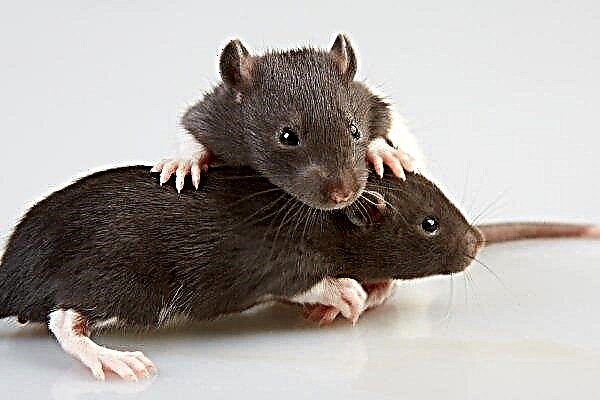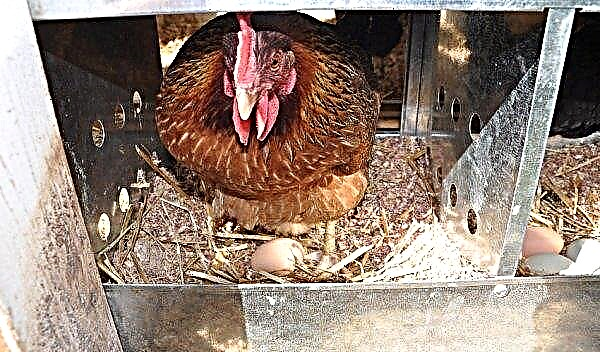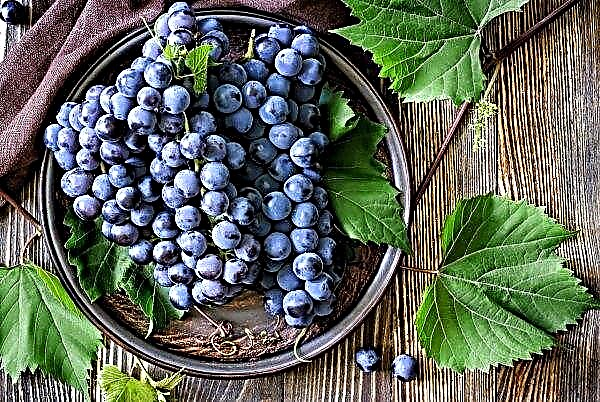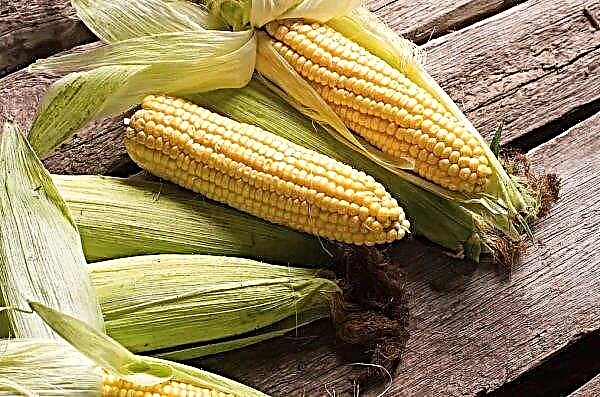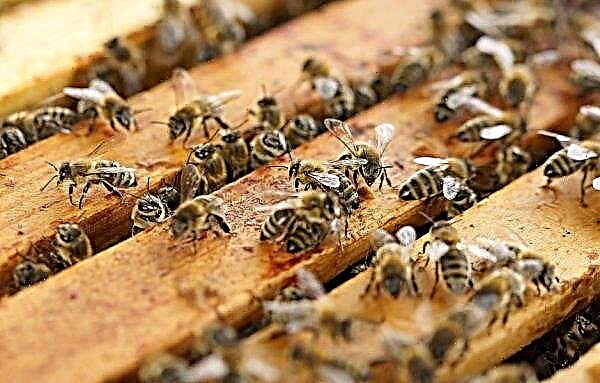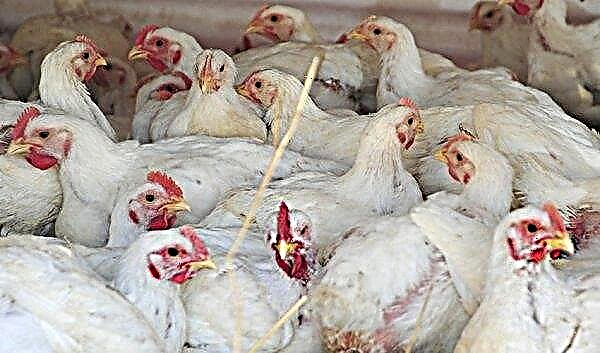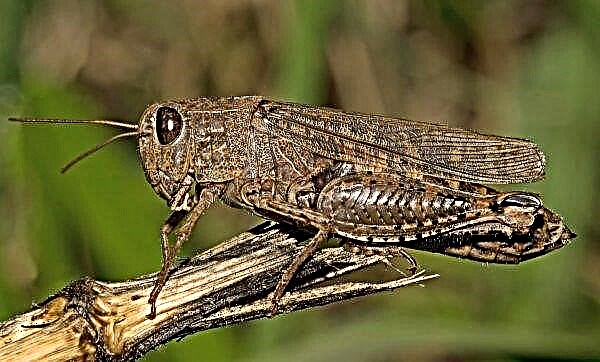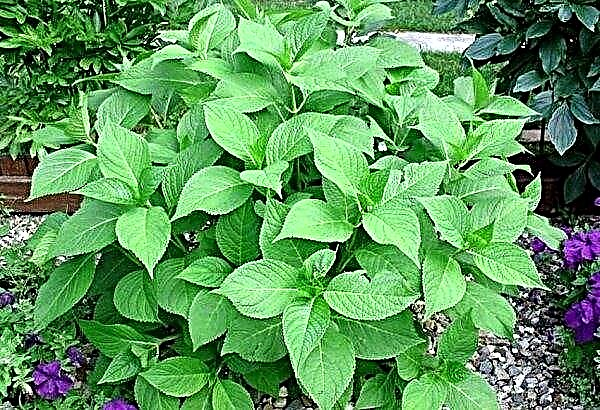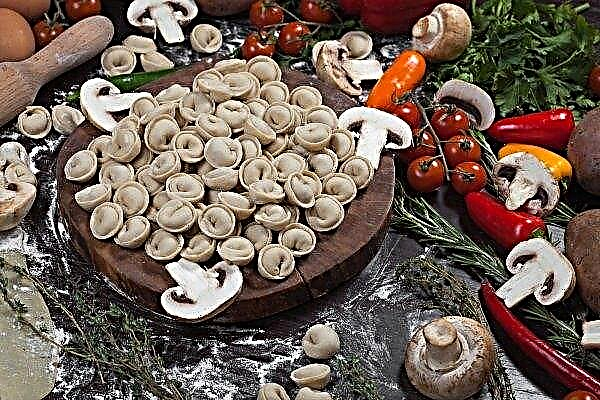In the process of cultivating any crop, including cucumbers, gardeners often encounter various difficulties. Especially fatal can be the effect of common diseases, one of which is a mosaic - an ailment that can destroy up to 70% of plants in the shortest possible time, leaving no chance of preserving the crop. In this article, we will consider what to do at the first signs of a mosaic, the causes of its occurrence, as well as methods of treatment and prevention of the development of the disease.
Description of the disease
Mosaic is an extremely harmful viral disease that affects not only cucumbers, but also crops such as cabbage, pumpkin, garlic, tomatoes, peppers, beans and many others. The causative agent of the misfortune is the Cucumber mosaic cucumovirus (CMV) virus, which, due to its microscopic size, can slip through the thinnest bacterial filters, for which it is also called "filtering". The main danger and peculiarity of the mosaic is the presence of a host carrier - aphids, which is why the disease was widespread precisely in open ground conditions. Localization of the pathogen occurs mainly in plant cells, however, its shelf life in plant debris and soil can reach several tens of years.
The main danger and peculiarity of the mosaic is the presence of a host carrier - aphids, which is why the disease was widespread precisely in open ground conditions. Localization of the pathogen occurs mainly in plant cells, however, its shelf life in plant debris and soil can reach several tens of years.
In addition to insects, other sources of the virus are:
- infected seed material;
- plant remains of the previous generation of the crop;
- weeds growing near the area with crops;
- contaminated garden tools.
Before people became aware of the nature and measures to combat the mosaic virus, it inflicted huge damage on all crops, in particular tobacco.
Did you know? The beneficial properties of cucumber were known even before our era - the ancient Greek physician Hippocrates repeatedly mentioned his ability to treat most diseases. A little later, Christopher Columbus, during his travels, forced sailors to eat both fresh and pickled cucumbers in order to prevent scurvy.
Today, several varieties of the disease are known:
- tobacco mosaic;
- speckled green;
- white
- ordinary.
Of these, you can often find green speckled mosaic and ordinary mosaic on cucumbers. The disease destroys plants at the cellular level, leading to the death of tissues and disruption of all vital processes. Infection most often occurs through mechanical damage to the fruit, however, healthy cucumbers in contact with diseased specimens will not avoid this fate. Having penetrated the damaged areas into the plant, the virus tends to get through the vessels, first to the root, and then to the stalk of the cucumber, destroying tissue cells and chloroplasts in its path. The harmfulness of the disease is extremely high - in just a few weeks, the virus can destroy up to 70% of the crop. To protect their crops from irreparable losses, each gardener should familiarize themselves with the signs of the disease, the conditions for its development and preventive measures that will prevent the virus from appearing in the area itself or near it in the future.
The harmfulness of the disease is extremely high - in just a few weeks, the virus can destroy up to 70% of the crop. To protect their crops from irreparable losses, each gardener should familiarize themselves with the signs of the disease, the conditions for its development and preventive measures that will prevent the virus from appearing in the area itself or near it in the future.
The causes of the disease
Since one of the vectors of the virus is seed, the infection can be present for a long time on the site, without any manifestation. To activate the pathogen, a combination of a number of factors is necessary, including:
- Incorrect temperature conditions. Since the cucumber is a plant of tropical origin, low temperatures can be extremely fatal to it. Any indicators below + 16 ° C lead to a halt in the growth and development of the vegetable, which begins to spend the remainder of the nutrients to maintain the basic biological processes. In the case of a long stay of plants at temperatures below + 11 ° C, these processes stop, and they quickly die. However, the opposite is also undesirable for cucumbers - at temperatures above + 29 ° С, the substances responsible for the accumulation of energy for plant growth slow down their formation, and since in the first and second cases there is a lack of this energy, the tissues become susceptible to most infections . That is why it is very important to maintain a middle ground and establish a suitable temperature regime for cucumber crops - +23 ... + 28 ° С.
- Soil moisture. In the absence of sufficient moisture, the plants cease to receive nutrients from the soil, which must come through the roots exclusively in dissolved form. The reverse situation is also detrimental to plants - waterlogging entails oxygen starvation of the root system. For the vast majority of pathogens, water is a favorable environment, and therefore the roots weakened by a lack of air become vulnerable to damage. As in the previous case, it is necessary to control this process and monitor the humidity of the substrate - it is best to wait until the soil is slightly dry, and only then proceed with the irrigation procedure.
- Air humidity. For full growth and development, cucumbers need high humidity - at least 85%. At a lower rate, the accumulated moisture in the plants begins to evaporate quickly, which leads to an excessive expenditure of energy and weakening of the plants. If the humidity level on the site varies between 95–100%, then the reverse process occurs - the appearance of dew, which serves as a kind of “portal” for dangerous infections.
- Frequency of top dressing. The introduction of minerals is one of the most important procedures for increasing productivity, but it is precisely this that can cause infection with a harmful ailment. The thing is that this event requires a certain periodicity - the main substances, including phosphorus, nitrogen and potassium, should be applied to the soil no more than once a week during the period of active fruiting. An excess of nitrogenous fertilizers leads to poor absorption of other vital components, as a result of which plants become susceptible to attack by various viruses. A similar situation occurs with a lack of minerals - cucumbers will weaken as a result of a slowdown in growth and development and will soon become victims of infection.
- Lack of genetic resistance. Often seedlings that are not inherent in such genes in the development process easily become susceptible to any manifestations and forms of disease. Today, breeders have bred a huge number of varieties resistant to the most common diseases, therefore, in order to avoid the risk of infection of crops, it is recommended to purchase them.
Important! Choose planting material with a 3-year shelf life for planting, because after this time the infection level in the seeds will be minimal.
Characteristic signs of the disease
The first symptom of the disease can be a certain deformation of the leaf plates - as the pathogen develops, they begin to frown, then dry and curl. The spots on the leaves resemble a mosaic - dark and light areas alternate with each other, giving them a variegated color.
Other signs of mosaic crop damage include the following:
- significant curvature of plant stems and the formation of cracks in them;
- almost complete absence of the formation of flowers on the bush or a significant decrease in their size;
- rapid drying and yellowing of greenhouses;
- at the chronic stage, discoloration of the bush and its complete wilting.
 The negative influence of the virus affects the entire plant - in addition to slowing down growth and development, it often also ceases to bear fruit. As for the fruits themselves, in the event of the appearance of the mosaic they become unsuitable for consumption - dwarf, spotted, with a palpable taste of bitterness, cucumbers lose their market value.
The negative influence of the virus affects the entire plant - in addition to slowing down growth and development, it often also ceases to bear fruit. As for the fruits themselves, in the event of the appearance of the mosaic they become unsuitable for consumption - dwarf, spotted, with a palpable taste of bitterness, cucumbers lose their market value.Did you know? In the Pacific Islands, cucumbers are treated like a real delicacy: Aborigines burrow them in the ground, storing numerous supplies of vegetables in case of bad weather or a food crisis, and the bride’s parents do not approve the daughter’s marriage with the groom until he provides their supplies of cucumber, by proving his worth and seriousness of intentions.
An ailment can affect the culture at any time during the growing season, however, cucumbers at the seedling stage are most susceptible to the pathogen. It is known that in resistant cucumber varieties the incubation period lasts about a month, and in susceptible plants it is no more than 11 days. That is why timely detection of the disease can prevent further infection of crops and destroy a malicious infection.
Cucumber Mosaic Treatment
Treatment of cucumber crops from an ailment is possible mainly with folk remedies and the implementation of preventive actions, since a chemical preparation that contributed to the destruction of mosaics was not invented. As an alternative, some gardeners use a number of fungicides, which, in combination with simple agricultural techniques, give a positive result. Let us consider in more detail the necessary dosages for drugs and folk remedies.
Using drugs
The virus is quite resistant to chemicals, so it is undesirable to be limited to one treatment. The most effective fungicides in the fight against the disease are Actellik, Aktara and Burgundy liquid. For the first two preparations, the dosage will be the same - 85 g per 10 liters of water, which in the future should be consumed at the rate of 1 liter for each cucumber bush. To prepare the Burgundy liquid, several components are necessary: 90 g of copper sulfate, 50 g of liquid soap, 50 g of soda and 10 l of water.
Important! In the case of growing cucumbers in a greenhouse, refrain from planting pumpkins next to them, since it can store the cucumber mosaic virus in itself for a long time.
For this, copper sulfate is dissolved in water at the same time, and soda is dissolved in liquid soap, after which liquid copper is added to the resulting soda solution. Treatment with a solution and preparations should be carried out no more than once a week, since the toxins contained in them can adversely affect the fruits.
Prevention of mosaic is also impossible without chemicals - treat crops at an early stage of vegetation with a 3% solution of Farmayoda, the dosage of which is 0.4 kg per 1 ha of area. However, it should be remembered that these funds are not intended to destroy the mosaic, and therefore all that can be achieved with their help is only to slow down the development of the disease.
Folk remedies
From folk remedies, a 10 percent solution of skim milk, which can inhibit the spread of the disease, has proven itself well. A good option is also the use of whey and mullein mixture in the following proportions - 1 kg of mullein per 10 liters of water and 1 tbsp. l urea.
The tool will significantly speed up the treatment process, while disinfecting the soil and making it suitable for subsequent crops. If the moment at the initial stage of the disease was missed and the disease progressed, then whey diluted with water in the ratio 1: 2 will help.
For greater effectiveness, you can also add a few drops of iodine to it. It is also possible to treat mosaics with the help of various tinctures - dandelion, tobacco, onion husks. Processing with these solutions, as in the case of chemicals, should be done no more than once a week. It is worth noting that folk remedies in 90% of cases give a positive and long-term result.
Disease Prevention
Long and costly treatment can be avoided only if favorable conditions are created for cucumbers, because any disease is always easier to prevent than to treat. You can defeat the disease by taking timely measures and qualitatively eliminating the affected plants from the site.
The main agrotechnical techniques that can prevent the appearance of mosaics include the following:
- regular examination of plants for infection;
- systematic control of weeds growing near cucumber crops;
- timely and thorough removal of plant debris from the site;
- sowing high-quality and virus-resistant seed material;
- observance of crop rotation standards;
- regular disinfection of garden equipment;
- immediate removal from the site of diseased specimens and subsequent tillage;
- the fight against the pest-carrier of the mosaic - aphid;
- compliance with the basic rules of growing crops: temperature, humidity, frequency of fertilizing and watering.
 Mosaic is one of the most harmful and intractable diseases that can deprive a gardener of a long-awaited crop of cucumbers in a matter of days. Protecting crops from adversity can only be achieved by providing the crop with proper care and prevention, and then no ailments will be afraid of healthy and strong cucumber crops.
Mosaic is one of the most harmful and intractable diseases that can deprive a gardener of a long-awaited crop of cucumbers in a matter of days. Protecting crops from adversity can only be achieved by providing the crop with proper care and prevention, and then no ailments will be afraid of healthy and strong cucumber crops.

